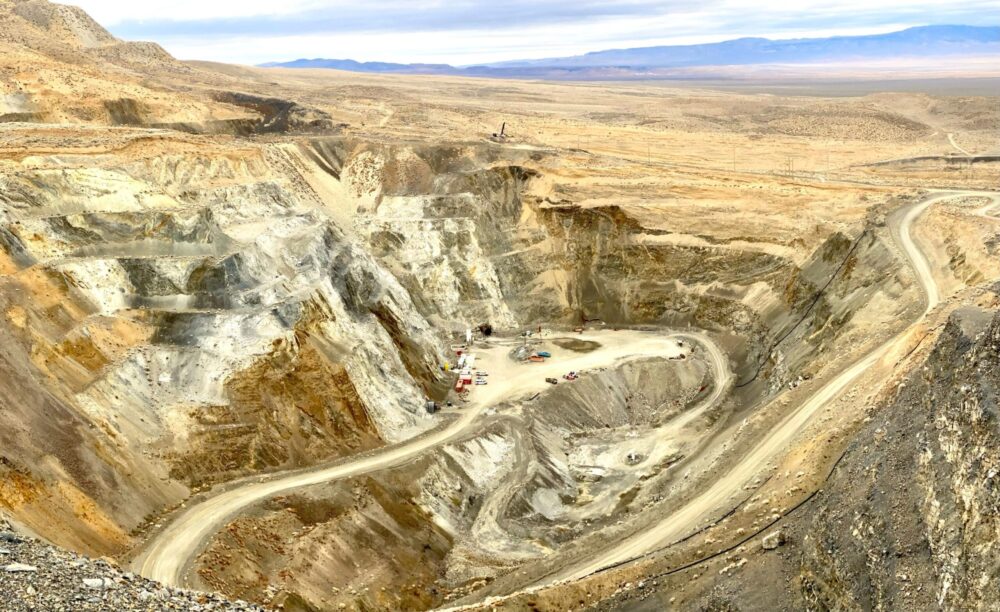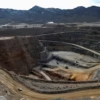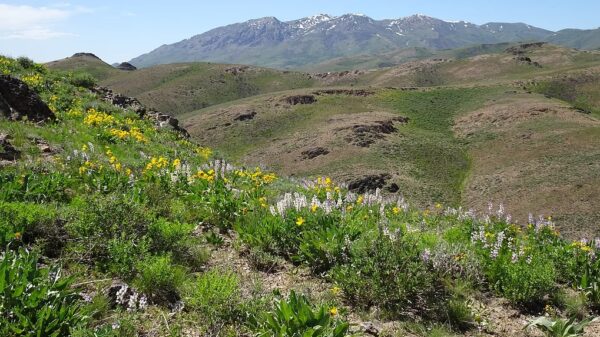i-80 Gold Corp. (TSE: IAU) (NYSE: IAUX) is pushing ahead with one of the most aggressive mine-building plans in Nevada, relying on geology, infrastructure and a phased development strategy to vault the company into the top tier of mid-tier U.S. gold producers.
The company outlined this roadmap on Sunday after a year of accelerating work across its Battle Mountain-Eureka Trend properties.
President and CEO Richard Young said the company set a three-phase development plan a year earlier to lift annual output from under 50,000 ounces to more than 600,000 ounces. He described it as a shift from a smaller producer into a major Nevada player. The strategy relies on an integrated network of underground and open-pit mines feeding a refurbished autoclave at Lone Tree.
The company is advancing multiple projects across some of Nevada’s most productive gold belts. It plans to restart its autoclave to regain processing control and reduce toll milling costs. This approach allows the team to rely on existing infrastructure while it brings new ore sources online in sequence.
Nevada offers more than favourable geology. The state’s mining workforce and regulatory structure support companies that plan long development timelines. Young said these advantages matter when building several mines at once. The company’s development plan blends short-term production growth with longer-term resource expansion to maintain discipline in varying gold markets.
Third-quarter results showed momentum as i-80 posted its strongest gross profit to date. The improvement came as production increased at Granite Creek, even though toll milling kept costs high. Young said the quarter marked a forward step for operations as the company ramps up ore from Granite Creek’s underground workings.
Read more: NevGold edges closer to gold-antimony resource with latest Limousine Butte results
Read more: GoldMining chooses to retain its NevGold shares for next 18 months
Company has over $100M in cash
Revenue rose on higher gold sales, but processing costs remained steep. Toll milling charges between USD$1,000 and USD$1,500 per ounce continue to distort the company’s economics. Young said this issue should end once the Lone Tree autoclave restarts, adding that investors may misread current margins because of these temporary charges.
The company expects production to reach roughly 200,000 ounces a year by 2028. It estimates EBITDA of USD$200 million to USD$300 million depending on gold prices. That growth depends on advancing the Archimedes and Cove underground mines while improving performance at Granite Creek. All three will eventually feed the autoclave.
The company held just over USD$100 million in cash at quarter-end. It raised $92 million in the second quarter to support the next stage of development, giving i-80 sufficient capital through mid-2026. Meanwhile, management is pursuing long-term project financing to cover the full development sequence.
Water management at Granite Creek has been the biggest operational obstacle. The company could not access deeper zones without a permanent dewatering system. It installed that system during the third quarter, allowing water to be pumped to surface.
The company will also construct a water treatment plant in early 2025 to release treated water into the local basin. That change prevents water from returning underground, which has slowed development. Better water control allows miners to reach deeper zones where grades and ground conditions improve.
Improved conditions lead to faster advance rates and less dilution, both key to underground mine economics. The company expects unit mining costs to fall as rates increase. However, toll milling charges will continue to mask these improvements until the autoclave runs again.
Read more: NevGold delivers major growth at Idaho gold project
Read more: Antimony recovery results from NevGold’s Limo Butte project exceed expectations
i-80 drilling in early November
i-80 completed more than 53,000 feet of drilling in the third quarter. The programs included infill at multiple deposits and step-out drilling to test extensions. Management said the results exceeded internal expectations. At Cove, the mineralized envelope expanded between 10 per cent and 20 per cent from earlier estimates.
Granite Creek drilling has also returned solid grades. A 47-hole program finishing in mid-December produced consistent intercepts from 35 reported holes. The South Pacific Zone remains a major target, and step-out drilling encouraged more holes to fill gaps between intercepts.
The company sees strong geological links between Granite Creek and Turquoise Ridge, a roughly 30-million-ounce deposit owned by Nevada Gold Mines, a joint venture between Barrick Mining Corp (TSE: ABX) (NYSE: B) (ETR: ABR0) and Newmont Corporation (TSE: NGT) (NYSE: NEM) (FRA: NMM). Management expects deeper Granite Creek zones to show similar improvements in grade and continuity.
i-80 began drilling at Archimedes in early November. The upper zone will be drilled into the first quarter, and the lower zone will follow through 2025. This work supports a feasibility study planned for early 2027.
The company released five preliminary economic assessments (PEAs) in early 2025 covering its main gold deposits. Young said the PEAs used conservative assumptions and would improve with more drilling. He said the larger resource base at Cove already confirms that view.
Three feasibility studies will arrive between early 2026 and early 2027 for Granite Creek, Archimedes and Cove. These studies will include larger reserves than the PEAs but similar cost assumptions. Staff said the most important drivers are the larger resource bases and longer mine lives.
Read more: NevGold closes its Nutmeg Mountain acquisition with Goldmining for $3 million
Read more: NevGold’s latest Nevada drill results show exceptional gold mineralization
Nevada’s regulatory system has clear processes
Granite Creek’s study will incorporate mine life gains from the South Pacific Zone. The Range Fault Zone may offer more upside in future updates. Archimedes will draw on earlier work done by Barrick, and engineering is advancing in parallel with drilling.
Permitting work continues across the portfolio. Environmental baseline studies are underway, and the company plans to accelerate Mineral Point. Barrick had already completed major baseline work there, putting the project ahead of schedule. i-80 now plans to conduct infill drilling and technical studies in 2026, which requires about $40 million from its recapitalization process.
That faster schedule could support earlier permitting for Archimedes below the 5100 level, which in turn allows Mineral Point to move forward sooner. The company wants permits for Mineral Point, Cove and Granite Creek open pit by late 2028. This timing expands future production options.
The permitting approach focuses on parallel progress rather than a linear project-by-project pathway. Nevada’s regulatory system has clear processes, and i-80’s experience with state agencies helps keep approvals on track. Several sites also contain previous disturbances from older mines, which may simplify review.
The Lone Tree autoclave refurbishment remains the company’s most important near-term project. Hatch Engineering, which built the autoclave originally, completed much of the design work for the restart. Young said the refurbishment will cost around USD$400 million. Additionally, he said that higher margins of $1,000 to $1,500 per ounce after restart should create a fast payback.
The company hired an owner’s team with direct experience operating this autoclave. The board further approved a USD$25 million limited notice to proceed, allowing Hatch to begin ordering long-lead equipment and to start permitting for new components.
Read more: NevGold targets U.S. critical mineral supply chain with new antimony-gold find
Read more: NevGold Expands Gold-Antimony Potential at Limousine Butte in Nevada
Company continues to strengthen it technical team
The development schedule targets first gold from the autoclave before the end of 2027. Meeting that goal is essential for achieving the 2028 production targets, since toll milling remains the largest drag on profits.
Management is advancing recapitalization talks with several financing groups. Young said the company has six term sheets and intends to present two or three final options to the board. The goal is to secure funds for all three development phases and complete feasibility and permitting work on schedule.
The company also continues to strengthen its technical team to support this workload. Nevada’s deep talent pool has allowed i-80 to hire experienced mining engineers, metallurgists and geologists. Young said that strong mid-level staffing is essential, as those teams complete the detailed work required for complex mine development.
Collaboration among these technical groups has allowed i-80 to advance drilling, engineering, permitting and operations at the same time. Nevada’s mining culture and experienced workforce help companies manage the competing demands of multi-mine development.
Young said previous companies he worked with struggled when they could not hire enough skilled staff. He said Nevada offers a rare combination of strong geology and a deep labour pool, which supports the kind of multi-asset plan i-80 is now executing.
.














